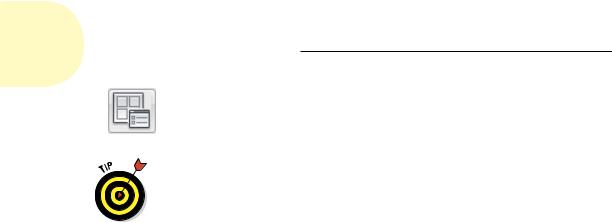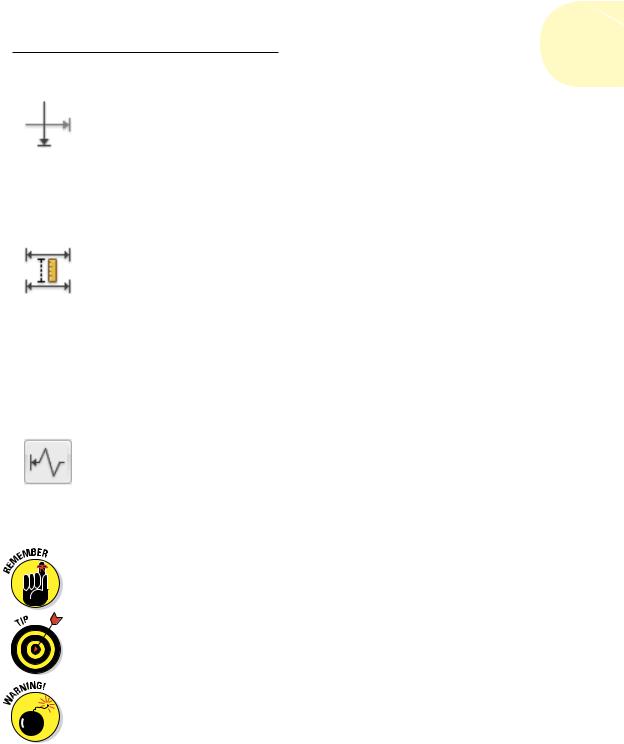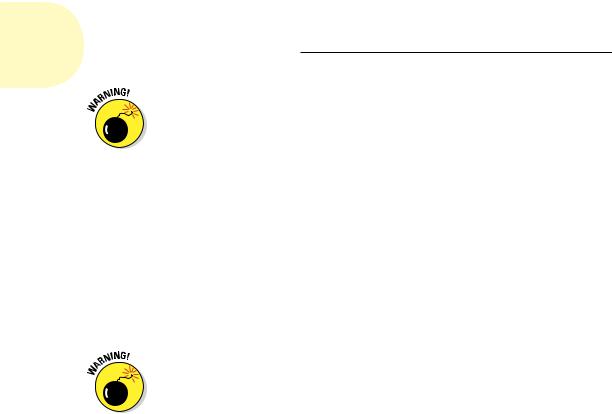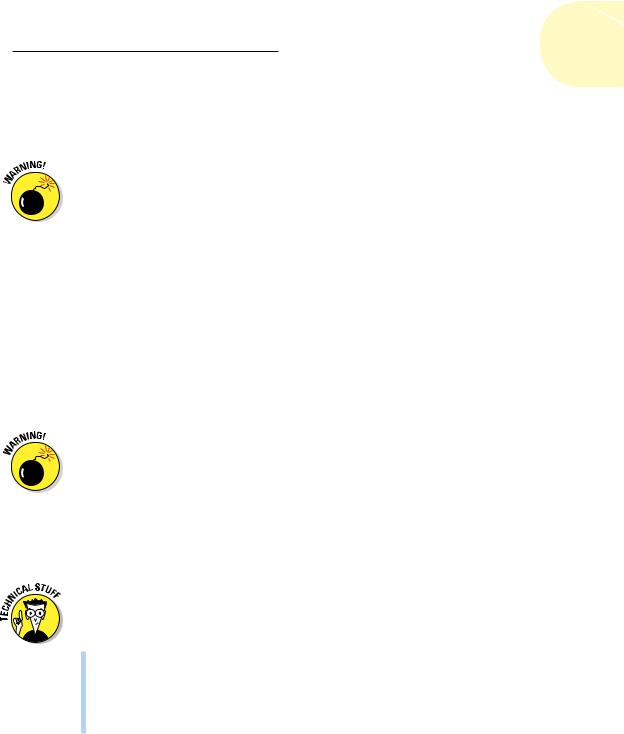
- •About the Authors
- •Dedication
- •Authors’ Acknowledgments
- •Table of Contents
- •Introduction
- •What’s Not (And What Is) in This Book
- •Mac attack!
- •Who Do We Think You Are?
- •How This Book Is Organized
- •Part I: AutoCAD 101
- •Part II: Let There Be Lines
- •Part III: If Drawings Could Talk
- •Part IV: Advancing with AutoCAD
- •Part V: On a 3D Spree
- •Part VI: The Part of Tens
- •But wait . . . there’s more!
- •Icons Used in This Book
- •A Few Conventions — Just in Case
- •Commanding from the keyboard
- •Tying things up with the Ribbon
- •Where to Go from Here
- •Why AutoCAD?
- •The Importance of Being DWG
- •Seeing the LT
- •Checking System Requirements
- •Suddenly, It’s 2013!
- •AutoCAD Does Windows (And Office)
- •And They’re Off: AutoCAD’s Opening Screens
- •Running with Ribbons
- •Getting with the Program
- •Looking for Mr. Status Bar
- •Let your fingers do the talking: The command window
- •The key(board) to AutoCAD success
- •Keeping tabs on palettes
- •Down the main stretch: The drawing area
- •Fun with F1
- •A Simple Setup
- •Drawing a (Base) Plate
- •Drawing rectangles on the right layers
- •Circling your plate
- •Nuts to you
- •Getting a Closer Look with Zoom and Pan
- •Modifying to Make It Merrier
- •Hip-hip-array!
- •Stretching out
- •Crossing your hatches
- •Following the Plot
- •A Setup Roadmap
- •Choosing your units
- •Weighing up your scales
- •Thinking annotatively
- •Thinking about paper
- •Defending your border
- •A Template for Success
- •Making the Most of Model Space
- •Setting your units
- •Making the drawing area snap-py (and grid-dy)
- •Setting linetype and dimension scales
- •Entering drawing properties
- •Making Templates Your Own
- •Setting Up a Layout in Paper Space
- •Will that be tabs or buttons?
- •View layouts Quick(View)ly
- •Creating a layout
- •Copying and changing layouts
- •Lost in paper space
- •Spaced out
- •A view(port) for drawing in
- •About Paper Space Layouts and Plotting
- •Managing Your Properties
- •Layer one on me!
- •Accumulating properties
- •Creating new layers
- •Manipulating layers
- •Using Named Objects
- •Using AutoCAD DesignCenter
- •Copying layers between drawings
- •Controlling Your Precision
- •Keyboard capers: Coordinate input
- •Understanding AutoCAD’s coordinate systems
- •Grab an object and make it snappy
- •Other Practical Precision Procedures
- •Introducing the AutoCAD Drawing Commands
- •The Straight and Narrow: Lines, Polylines, and Polygons
- •Toeing the line
- •Connecting the lines with polyline
- •Squaring off with rectangles
- •Choosing your sides with polygon
- •(Throwing) Curves
- •Going full circle
- •Arc-y-ology
- •Solar ellipses
- •Splines: The sketchy, sinuous curves
- •Donuts: The circles with a difference
- •Revision clouds on the horizon
- •Scoring Points
- •Commanding and Selecting
- •Command-first editing
- •Selection-first editing
- •Direct object manipulation
- •Choosing an editing style
- •Grab It
- •One-by-one selection
- •Selection boxes left and right
- •Perfecting Selecting
- •AutoCAD Groupies
- •Object Selection: Now You See It . . .
- •Get a Grip
- •About grips
- •A gripping example
- •Move it!
- •Copy, or a kinder, gentler Move
- •A warm-up stretch
- •Your AutoCAD Toolkit
- •The Big Three: Move, Copy, and Stretch
- •Base points and displacements
- •Move
- •Copy
- •Copy between drawings
- •Stretch
- •More Manipulations
- •Mirror
- •Rotate
- •Scale
- •Array
- •Offset
- •Slicing, Dicing, and Splicing
- •Trim and Extend
- •Break
- •Fillet and Chamfer and Blend
- •Join
- •When Editing Goes Bad
- •Zoom and Pan with Glass and Hand
- •The wheel deal
- •Navigating your drawing
- •Controlling your cube
- •Time to zoom
- •A View by Any Other Name . . .
- •Looking Around in Layout Land
- •Degenerating and Regenerating
- •Getting Ready to Write
- •Simply stylish text
- •Taking your text to new heights
- •One line or two?
- •Your text will be justified
- •Using the Same Old Line
- •Turning On Your Annotative Objects
- •Saying More in Multiline Text
- •Making it with Mtext
- •It slices; it dices . . .
- •Doing a number on your Mtext lists
- •Line up in columns — now!
- •Modifying Mtext
- •Gather Round the Tables
- •Tables have style, too
- •Creating and editing tables
- •Take Me to Your Leader
- •Electing a leader
- •Multi options for multileaders
- •How Do You Measure Up?
- •A Field Guide to Dimensions
- •The lazy drafter jumps over to the quick dimension commands
- •Dimension associativity
- •Where, oh where, do my dimensions go?
- •The Latest Styles in Dimensioning
- •Creating and managing dimension styles
- •Let’s get stylish!
- •Adjusting style settings
- •Size Matters
- •Details at other scales
- •Editing Dimensions
- •Editing dimension geometry
- •Editing dimension text
- •Controlling and editing dimension associativity
- •Batten Down the Hatches!
- •Don’t Count Your Hatches. . .
- •Size Matters!
- •We can do this the hard way. . .
- •. . . or we can do this the easy way
- •Annotative versus non-annotative
- •Pushing the Boundary (Of) Hatch
- •Your hatching has no style!
- •Hatch from scratch
- •Editing Hatch Objects
- •You Say Printing, We Say Plotting
- •The Plot Quickens
- •Plotting success in 16 steps
- •Get with the system
- •Configure it out
- •Preview one, two
- •Instead of fit, scale it
- •Plotting the Layout of the Land
- •Plotting Lineweights and Colors
- •Plotting with style
- •Plotting through thick and thin
- •Plotting in color
- •It’s a (Page) Setup!
- •Continuing the Plot Dialog
- •The Plot Sickens
- •Rocking with Blocks
- •Creating Block Definitions
- •Inserting Blocks
- •Attributes: Fill-in-the-Blank Blocks
- •Creating attribute definitions
- •Defining blocks that contain attribute definitions
- •Inserting blocks that contain attribute definitions
- •Edit attribute values
- •Extracting data
- •Exploding Blocks
- •Purging Unused Block Definitions
- •Arraying Associatively
- •Comparing the old and new ARRAY commands
- •Hip, hip, array!
- •Associatively editing
- •Going External
- •Becoming attached to your xrefs
- •Layer-palooza
- •Creating and editing an external reference file
- •Forging an xref path
- •Managing xrefs
- •Blocks, Xrefs, and Drawing Organization
- •Mastering the Raster
- •Attaching a raster image
- •Maintaining your image
- •Theme and Variations: Dynamic Blocks
- •Lights! Parameters!! Actions!!!
- •Manipulating dynamic blocks
- •Maintaining Design Intent
- •Defining terms
- •Forget about drawing with precision!
- •Constrain yourself
- •Understanding Geometric Constraints
- •Applying a little more constraint
- •AutoConstrain yourself!
- •Understanding Dimensional Constraints
- •Practice a little constraint
- •Making your drawing even smarter
- •Using the Parameters Manager
- •Dimensions or constraints — have it both ways!
- •The Internet and AutoCAD: An Overview
- •You send me
- •Send it with eTransmit
- •Rapid eTransmit
- •Bad reception?
- •Help from the Reference Manager
- •Design Web Format — Not Just for the Web
- •All about DWF and DWFx
- •Autodesk Design Review 2013
- •The Drawing Protection Racket
- •Autodesk Weather Forecast: Increasing Cloud
- •Working Solidly in the Cloud
- •Free AutoCAD!
- •Going once, going twice, going 123D
- •Your head planted firmly in the cloud
- •The pros
- •The cons
- •Cloudy with a shower of DWGs
- •AutoCAD 2013 cloud connectivity
- •Tomorrow’s Forecast
- •Understanding 3D Digital Models
- •Tools of the Trade
- •Warp speed ahead
- •Entering the third dimension
- •Untying the Ribbon and opening some palettes
- •Modeling from Above
- •Using 3D coordinate input
- •Using point filters
- •Object snaps and object snap tracking
- •Changing Planes
- •Displaying the UCS icon
- •Adjusting the UCS
- •Navigating the 3D Waters
- •Orbit à go-go
- •Taking a spin around the cube
- •Grabbing the SteeringWheels
- •Visualizing 3D Objects
- •Getting Your 3D Bearings
- •Creating a better 3D template
- •Seeing the world from new viewpoints
- •From Drawing to Modeling in 3D
- •Drawing basic 3D objects
- •Gaining a solid foundation
- •Drawing solid primitives
- •Adding the Third Dimension to 2D Objects
- •Creating 3D objects from 2D drawings
- •Modifying 3D Objects
- •Selecting subobjects
- •Working with gizmos
- •More 3D variants of 2D commands
- •Editing solids
- •Get the 2D Out of Here!
- •A different point of view
- •But wait! There’s more!
- •But wait! There’s less!
- •Do You See What I See?
- •Visualizing the Digital World
- •Adding Lighting
- •Default lighting
- •User-defined lights
- •Sunlight
- •Creating and Applying Materials
- •Defining a Background
- •Rendering a 3D Model
- •Autodesk Feedback Community
- •Autodesk Discussion Groups
- •Autodesk’s Own Bloggers
- •Autodesk University
- •The Autodesk Channel on YouTube
- •The World Wide (CAD) Web
- •Your Local ATC
- •Your Local User Group
- •AUGI
- •Books
- •Price
- •3D Abilities
- •Customization Options
- •Network Licensing
- •Express Tools
- •Parametrics
- •Standards Checking
- •Data Extraction
- •MLINE versus DLINE
- •Profiles
- •Reference Manager
- •And The Good News Is . . .
- •APERTURE
- •DIMASSOC
- •MENUBAR
- •MIRRTEXT
- •OSNAPZ
- •PICKBOX
- •REMEMBERFOLDERS
- •ROLLOVERTIPS
- •TOOLTIPS
- •VISRETAIN
- •And the Bonus Round
- •Index

318 Part III: If Drawings Could Talk
10.Double-click outside the viewport to return to the paper space layout.
11.Create a second viewport by using the VPORTS command, or simply COPY and then modify the existing one.
12.Repeat Steps 8 and 9 on the new viewport, but use a Viewport Scale
of 1:5.
Use the Lock/Unlock button to lock the viewports to prevent inadvertent messing with them.
There you have it! A multiview, multiscale detail drawing without duplicating any geometry or annotations. To see the real magic of this, go to the model space tab and observe that there is still only one model of the part and no detail at the other scale. Now use the STRETCH command to play with the depth and location of the notch. Go back to the Layout 1 tab to see how everything has automatically updated in both views. Magic!
Editing Dimensions
After you draw dimensions, you can edit the position of the various parts of each dimension and change the contents of the dimension text. AutoCAD groups all the parts of a dimension into a single object.
Editing dimension geometry
The easiest way to change the location of dimension parts is to use grip editing, which we describe in Chapter 10. Just click a dimension, click one of its grips, and maneuver away. You’ll discover that certain grips control certain directions of movement. In general, selecting a dimension displays grips at the text, the ends of the dimension lines, and the defpoints. Experiment for a few minutes to see how they work.
In AutoCAD 2012, dimensions joined the group of objects that feature multifunction grips. Click the text grip on a linear dimension and use the grip menu to adjust the text location. Click an arrow grip, and you can create a continuous or baseline dimension from that end of the dimension, or you can flip the arrow. You can do these things by selecting a dimension and changing items in the Properties palette, but the multifunction grips make it a lot more efficient.
If you want to change the look of a component of a specific, individual dimension (for example, substitute a different arrowhead or suppress an extension line), use the Properties palette. (See Chapter 11 for more on the Properties palette.) All the dimension settings in the New/Modify Dimension Style dialog boxes (see “Adjusting style settings,” earlier in this chapter) are available from the Properties palette when you select one or more dimensions.
www.it-ebooks.info

Chapter 14: Entering New Dimensions 319
More fine tweaking
In manual drafting, it’s considered bad form to cross object lines (that is, real geometry) with dimension lines or extension lines, or to have anything cross a dimension line. Dimension Break (DIMBREAK) prompts you to select a dimension and then an object to break it. The really wild thing here is that this is a smart break. If you do anything to the dimension or to the object being broken to change where they cross, then the break follows accordingly — and if you change either item so that they no longer cross — the break heals itself. Better yet, if you change things yet again so that they cross again, the break reappears!
The Dimension Space (DIMSPACE) command applies a specified separation between existing linear or angular dimensions. Spacing dimensions equally — if you don’t use the DIMBASELINE command as they’re created — requires tedious manipulation with Snap and MOVE.
A fundamental mantra in AutoCAD is that you should always draw everything full-size. There may be occasions, however, where this isn’t always practical. For example, you may be designing a power-transmission shaft for a large machine. The shaft is 4" in diameter and 12' long. It has a variety of splines, keyways, and bearing shoulders on each end, but the 11' section in the middle is simply a straight cylinder. If you draw it full-size and scale the plot to fit a suitable paper size, you’ll never see the details at each end.
Common practice is to draw the interesting end details but to break out and remove the boring center section, bringing the ends closer together. Now you can create a reasonable plot. The problem is that any dimension that crosses over the break, such as the overall length, won’t show the correct value. The solution is to override the value (we explain how a little later in this chapter) and then to use the DIMJOGLINE command to insert a jog in the dimension line to indicate that the dimension line isn’t the true length.
In spite of the name similarities, don’t confuse DIMJOGLINE with the DIMJOGGED command covered earlier. DIMJOGLINE is for linear dimensions and DIMJOGGED is for radial dimensions.
If you select one or more dimensions and right-click, the menu displays a number of useful options for overriding dimension settings or assigning a different style.
When you change a setting in the Properties palette, you’re overriding the default style setting for that dimension. If you need to make the same change to a bunch of dimensions, it’s usually better to create a new dimension style and assign that style to them. You can use the Properties palette or the rightclick menu to change the dimension style that’s assigned to one or more dimensions.
www.it-ebooks.info

320 Part III: If Drawings Could Talk
Earlier in this chapter, we describe the pre-DimStyle days when we had to manually change DimVars to get different dimension appearances. This process still works, but it can cause all sorts of problems. If you manually change a DimVar setting, this gets applied to the current dimension style as an override, and all subsequent dimensions that are placed by using this style have the overridden appearance. This can cause much the same problem as overriding object properties instead of using different layers; if you edit a dimension style, then all existing dimensions that use it update, including the ones that you hadn’t expected because they seem to be different from the desired ones.
You can use the Properties palette to turn on AutoCAD’s background mask feature (described in Chapter 13) for the text of individual dimensions: Select the dimensions, display the Text area in the Properties palette, and find the Fill Color item. Click in the list box, scroll down, and select Background to use the drawing background color (which usually gives the best results). To ensure that dimension text lies on top of other objects, use the DRAWORDER or TEXTTOFRONT command — see Chapter 13 for more information.
The AutoCAD EXPLODE command on the Home tab’s Modify panel will blow a dimension to smithereens — or at least into a bunch of line and multiline text objects. Don’t do it! Exploding a dimension makes it much harder to edit cleanly and eliminates AutoCAD’s ability to update the dimension text measurement automatically.
Editing dimension text
In most cases, you shouldn’t have to edit dimension text. Assuming that you draw your geometry accurately and pick the dimension points precisely, AutoCAD displays the right measurement. If you change the size of the associated object, AutoCAD updates the dimension and its measurement. However, you may occasionally want to override the dimension text (that is, replace it with a different measurement) or add a prefix or a suffix to the true measurement.
AutoCAD creates dimension text as multiline text, so dimension text has the same editing options as ordinary text. There are several ways of launching the dimension text editor, but the easiest is to simply double-click the dimension text.
AutoCAD displays the true dimension length as text in the actual dimension (and keeps the text up-to-date if you change the size or location of the object). You can override the true length by typing a specific length or other text string. You can preserve the true length but add a prefix or suffix by inserting <> (that is, the left and right angle-bracket characters) as placeholders for the dimension value. For example, if you enter About <> and the
actual distance is 12.000, AutoCAD displays About 12.000 for the dimension
www.it-ebooks.info

Chapter 14: Entering New Dimensions 321
text. If you stretch the object later on so that the actual distance changes to 14.528, AutoCAD changes the dimension text automatically to read About 14.528. Now you can appreciate the importance of drawing and editing geometry precisely!
Avoid the temptation to override the default dimension text by replacing the angled brackets with a numeric value unless you plan on using the
DIMBREAK command on the dimension. Doing so eliminates AutoCAD’s ability to keep dimension measurements current, but even worse, you get no visual cue that the default distance has been overridden (unless you edit the dimension text). If you’re overriding dimension text a lot, it’s probably a sign that the creator of the drawing didn’t pay enough attention to using precision techniques when drawing and editing. We’re not going to point any fingers, but you probably know whom to talk to.
Controlling and editing dimension associativity
When you add dimensions by selecting objects or by using Object Snap modes to pick points on the objects, AutoCAD normally creates associative dimensions, which are connected to the objects and move with them. This is the case in new drawings that were originally created in any release of AutoCAD starting with 2002.
If you have to work on drawings created or last edited in versions older than AutoCAD 2002, you must set the DIMASSOC system variable to 2 before later releases will create associative dimensions. An easy way to make this change for the current drawing is to open the Options dialog box (click the Application button and choose Options from the bottom of the Application
Menu), click the User Preferences tab, and turn on the Make New Dimensions Associative setting. Be aware that this setting affects only new dimensions that you draw from now on. To make existing non-associative dimensions associative, use the DIMREASSOCIATE command described in the following list. Look up DIMASSOC system variable in the AutoCAD help system for more information.
You aren’t likely to need any of these three commands very often, but if you do, look up the command name in the online help system:
DIMREASSOCIATE: If you have dimensions that aren’t currently associative (probably because they were created in older versions of AutoCAD) or are associated with the wrong objects, you can use the DIMREASSOCIATE command to associate them with points on the objects of your choice. DIMREASSOCIATE can be found on the Annotate tab’s Dimensions panel slideout, or you can just type DRE and press Enter.
www.it-ebooks.info

322 Part III: If Drawings Could Talk
DIMDISASSOCIATE: You can use the DIMDISASSOCIATE (DDA) command to sever the connection between a dimension and its associated object.
DIMREGEN: In a few special circumstances, AutoCAD doesn’t automatically update geometry-driven associative dimensions. (Maybe Autodesk should call them “usually-fully-awake-but-occasionally-asleep-at-the-wheel associative dimensions.”) In those cases, the DIMREGEN (no command alias) command will fix things.
The bad puns and witty jokes in this chapter came from our resident DimWit.
www.it-ebooks.info
